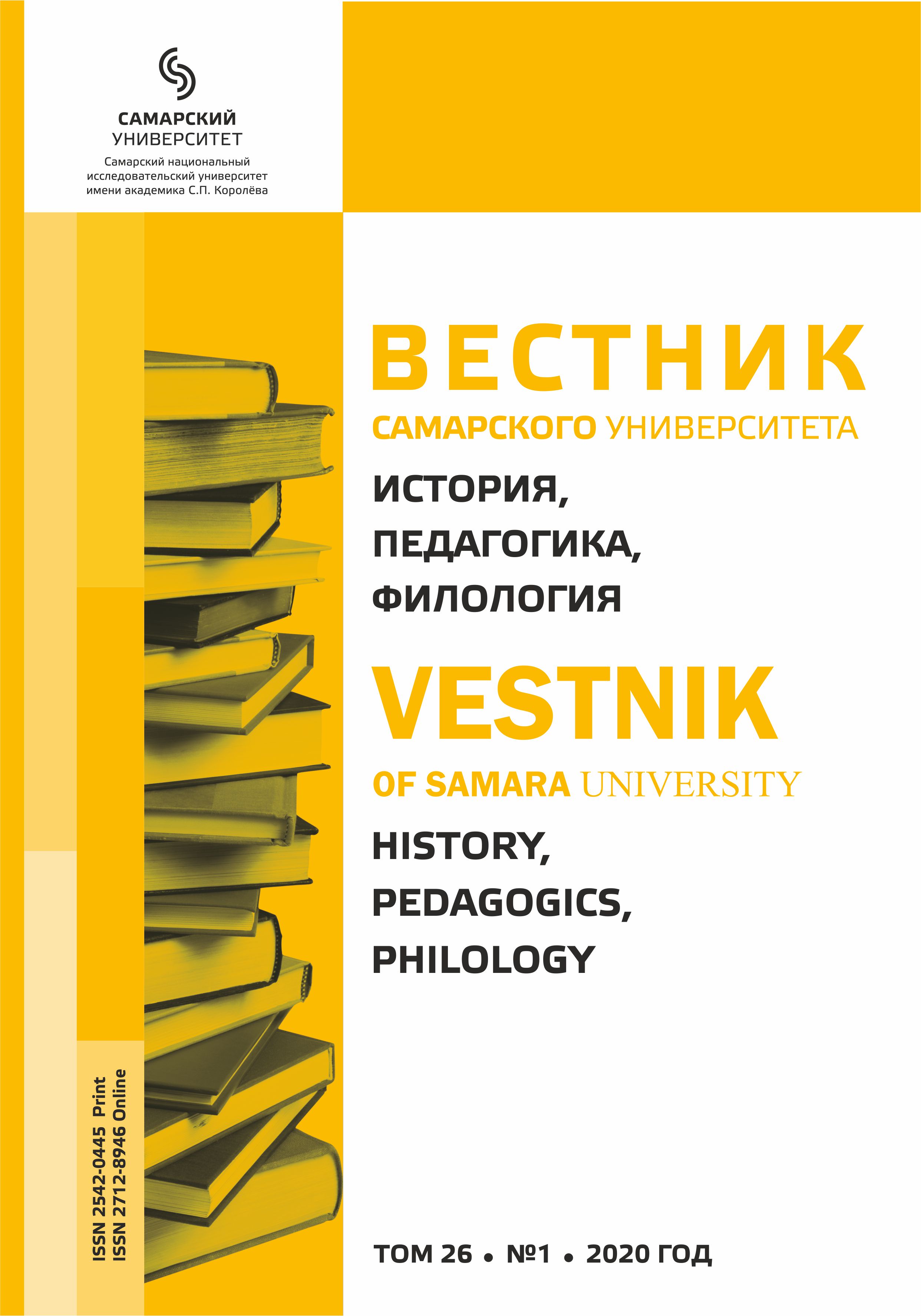Некоторые особенности использования парцелляции в интернет-коммуникации
- Авторы: Полидовец Н.И.1
-
Учреждения:
- Владимирский государственный университет имени А.Г. и Н.Г. Столетовых
- Выпуск: Том 26, № 1 (2020)
- Страницы: 106-111
- Раздел: Статьи
- URL: https://journals.ssau.ru/hpp/article/view/7736
- DOI: https://doi.org/10.18287/2542-0445-2020-26-1-106-111
- ID: 7736
Цитировать
Полный текст
Аннотация
Предметом исследования в статье являются особенности использования приема парцелляции в современной интернет-коммуникации. На основе анализа языкового материала, извлеченного из интернет-ресурсов российских форумов, сделана попытка анализа закономерности и частотности употребления приема парцелляции. Актуальность исследования заключается в отсутствии специальной литературы, посвященной данной теме в разрезе интернет-лингвистики. На этапе подготовки было определено, что авторы изучали явление парцелляции на материле художественной литературы и публицистики, в основном газет и журналов. Автором были поставлены следующие цели: выделить необходимое количество языкового материала для исследования явления парцелляции в интернет-лингвистике; на базе анализа специальной литературы вычленить основные функции парцелляции, свойственные интернет-лингвистике; классифицировать явление парцелляции в интернет-лингвистике по структуре, произвести подробное описание каждой категории. В статье были использованы работы таких лингвистов, занимающихся изучением парцелляции, как Н.С. Валгиной, Ю.В. Ванникова, Е.А. Иванчиковой, Н.В. Иноземцевой, Т.Н. Колокольцевой, А.П. Сковородникова и др. На материале исследования более 500 языковых единиц, извлеченных из федеральных и региональных сайтов, были сделаны выводы об относительной частотности использования парцелляции и разных конструкций в составе парцеллированных современной русскоязычной языковой личностью, об основных функциях парцелляции в интернет-коммуникации, а также об изменениях в русской пунктуации, связанных в том числе с продиктованными особенностями употребления парцелляции в интернет-коммуникации XXI века и активными процессами, происходящими в современном русском языке.
Об авторах
Н. И. Полидовец
Владимирский государственный университет имени А.Г. и Н.Г. Столетовых
Автор, ответственный за переписку.
Email: morenov@ssau.ru
ORCID iD: 0000-0003-3327-3120
аспирант кафедры русского языка
Список литературы
- Baron 2008 – Baron N.S. Always On: Language in an Online and Mobile World. Oxford: Oxford University Press, 2008. 289 p. DOI: http://dx.doi.org/10.1093/acprof:oso/9780195313055.001.0001.
- Castells 1996 – Castells M. The rise of the network society. The
- Information Age: Economy, Society and Culture. Cambridge MA; Oxford, UK: Blackwell, 1996. Vol. 1. 556 p. URL: http://onlinelibrary.wiley.com/doi/book/10.1002/9781444319514.
- Crystal 2011 – Crystal David. Internet linguistics: a student guide. Milton Park, Abingdon; New York, N.Y., 2011. 179 p. URL: http://benjamins.com/catalog/aral.35.2.07rin/fulltext/aral.35.2.07rin.pdf.
- Crystal 2002 – Crystal David. Language and the Internet. Cambridge: Cambridge University Press, 2002. 272 p. URL: http://journals.openedition.org/lexis/1831.
- McQuail 2005 – McQuail D. McQuail’s Mass Communication Theory. Sage Publications. 2005. 608 p. URL: http://docshare04.docshare.tips/files/28943/289430369.pdf.
- Stephens-Davidowitz 2017 – Stephens-Davidowitz S. Everybody Lies: Big Data, New Data, and What the Internet Can Tell Us About Who We Really Are. Harper Collins, 2017. 338 p. URL: http://www.wfae.org/post/everybody-lies-big-data-and-what-internet-can-tell-us-about-ourselves-0#stream/0.
- Богоявленская 2015 а – Богоявленская Ю.В. Воздействующий потенциал в газетном тексте // Филология и человек. 2015 а. № 2. URL: http://cyberleninka.ru/article/n/vozdeystvuyuschiy-potentsial-partsellyatsii-v-mediatekste/viewer.
- Богоявленская 2015 б – Богоявленская Ю.В. Конвергенция парцелляции и лексического повтора во французских и русских медиатекстах // Вестник Томского государственного университета. Филология. 2015 б. № 3 (35). C. 5–15. DOI: http://doi.org/10.17223/19986645/35/1.
- Валгина 2003 – Валгина Н.С. Современный русский язык: Синтаксис. 4-е изд., испр. Москва, 2003. 416 с. URL: http://yanko.lib.ru/books/language/ru/yanko.valgina_2003_416p_rasp_sl.ht.
- Ванников 2009 – Ванников Ю.В. Синтаксис речи и синтаксические особенности русской речи. Москва: Либроком, 2009. 296 с.
- Иванчикова 1977 – Иванчикова Е.А. Парцелляция, ее коммуникативно-экспрессивные и синтаксические функции // Русский язык и советское общество. Морфология и синтаксис современного русского литературного языка. Москва: Наука, 1977. С. 277–301. URL: http://b-ok2.org/book/3184654/892901.
- Иноземцева 2011 – Иноземцева Н.В. Парцелляция как основная синтаксическая модель заголовков англоязычных статей по методической проблематике // Вестник ОГУ. 2011. № 11 (130). C. 114–118. URL: http://vestnik.osu.ru/2011_11/21.pdf.
- Колокольцева 2001 – Колокольцева Т.Н. Специфические коммуникативные единицы диалогической речи / под ред. О.Б. Сиротининой: монография. Волгоград, 2001. 260 с. URL: http://window.edu.ru/catalog/pdf2txt/632/25632/8527.
- Морозова 2010 – Морозова О.Н. Особенности интернет-коммуникации: определение и свойства // Вестник Ленинградского государственного университета им. А.С. Пушкина. 2010. № 5. Т. 1. C. 150–158. URL: http://cyberleninka.ru/article/n/osobennosti-internet-kommunikatsii-opredelenie-i-svoystva.
- Низамутдинова 2017 – Низамутдинова К.Ф. Парцелляция в журнале «Русский репортер» // Вестник Волгоградского государственного университета. Серия 9. Исследования молодых ученых. 2017. № 15. С. 51–56. URL: http://yrw.jvolsu.com/attachments/article/580/Nizamutdinova.pdf.
- Сковородников 1978 – Сковородников А.П. О классификации парцеллированных предложений в современном русском литературном языке // Филологические науки. 1978. № 1. С. 59–67.
Дополнительные файлы













